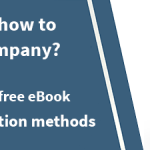Are you thinking of buying or selling a company? In the world of mergers and acquisitions, the business valuation process plays a fundamental role in determining the best estimate value for a business given all its counterparts. There are numerous advantages in understanding the intricacies of the valuation process that will be covered in this article, with the most obvious and prominent benefit being the understanding of the intrinsic value of a business – a vital milestone for its further sale.
It is essential to differentiate the value of a company from its price. The price is the specific value of a company materialized at the moment of the sale, depending on the supply and demand of the market at that moment. A value of a company is what every potential buyer gives a company depending on his profile and interests. It is the monetary measure of how useful the company is going to be for that person.
Table of contents
|
Importance of Conducting the Business Valuation process
Numerous business owners and entrepreneurs underestimate or simply are unaware of what the business valuation process entails and where it begins. This is a common scenario as the valuation process is a complex multistep process with different methods of approach. Independent of the valuation method you choose, valuating a company is a process where current value generating elements of the company are measured, as well as its competitive position within its sector and its future financial expectations. The type of valuation method used for analysis will then depend on factors such as the industry sector where the company operates, the size of the company, expected cash flow and the type of product or service it offers. For example, it is generally not advised to use the valuation method of comparable transactions if the sales volume or profits are 50% lower than that of the target company.
The valuation process is intrinsically technical, hence it is vitally important that whoever is conducting the valuation acquires financial knowledge. The valuator should also be aware of the company’s business model, its strategy, have a thorough understanding of the market where it operates, and the value-creating elements it acquires.
“ The main objective of the business valuation is to identify the key value-generating areas of the business.
The main objective of the valuation process is to identify the critical value-generating areas of the business. It is essential to consider which areas of your business may be of specific interest or value to the counterpart of the deal, as this will mostly determine the valuation results. For example, depending on the mindset and objectives of the investor, their interest may not be as much the profitability of the business, but perhaps the market share, strategic positioning, or a specialized area of the company’s value chain. The valuation result is then considered a significant estimation of a value range that will be a pivotal point in the negotiation of the final price paid for the deal. The valuation results are, therefore, important not only for identifying the key profit drivers of the business, but also setting a pinpoint for upcoming deal negotiations.
Factors to Consider
Before beginning the business valuation process, certain key factors must be taken into consideration. These include:
1. Profitability and risk. Substantially all of the considerations made during the valuation fall into two categories: profitability and risk. This is because an investor looks at the opportunity cost of making the deal, so if there is a deal that is as profitable but induces less risk, it is more likely to be an investment option.
2. Personal reasons. Investors are people too! Emotions or non-economic factors may influence the decision-making process and hence the valuation process results. For example, if a seller is motivated to sell his business as fast as possible, the factor of time will be of priority over selling at fair value due to any personal or emotional reason that may be the case. It is, therefore, vital to understand what the bottom line reasoning for the deal is for both counterparts of the transaction.
3. Company surroundings affect value. Companies are not islands. Their value depends on external factors and market forces. For example, if the stock market trades at multiple high volumes, your company will be worth more independent of its intrinsic value. Comparing to the value of the same company when the stock market is cool, even if your company is private and will remain to be so. This is because the stock market is an investment alternative for any investor. For example, if you are a construction company willing to invest, and you are offered a small-sized business industry for twice the value of the investment that could have been invested in a comparably larger sized firm’s shares on the stock market, the latter would have been the safest option for an investor. A company would have to have significant strategic value or potential for a buyer to consider it over the latter investment
4. Proper valuation requires valid information. Before considering performing a valuation and making future value predictions, the company’s past and present data must be accurate and correct. Only with this kind of data, and together with a strategic approach, a reliable estimation and valuable conclusions can be made. The more comprehensive and detailed the information you acquire about the business model, operations, and finances of the business before beginning the valuation, the better quality and precision the results will have.
Types of business valuations
There are several methods of valuation used, depending on the objective of the assessment. However, the two most prominent methods used by analysts are the discount free cash flows method and the comparable transactions method:
1.Discounted Free Cash Flow method (DCF).
This method aims to determine the company’s ability to generate wealth, estimating the money that the owners could take home with them during the company’s lifespan. This method is used to convert these future cash flows into today’s currency, using a “discount rate” to reflect future money’s value discounted to today’s value, including the potential risk associated with the said generation of wealth. Essentially, this method provides insight into the future performance of the company and its ability to generate cash flow via the company’s resources.
The Discounted Free Cash Flow method requires analysis of the past, historical data. This will provide an insight into which factors lead to incurred costs and which generated revenues. Particular attention should also be paid to the factors that might affect future financial projections. The function should include revenues, costs, profits, investment plans, projected cash flow, and the economic structure of the company. This projection will act as a hypothesis about future financial data (balances, income statements, etc.).
Also, market analysis and competitive positioning analysis must be taken into consideration when this valuation method is performed. Understanding the effects of the Porter´s five forces (barriers to entry, threat of substitutes, negotiation power of buyer, negotiation power of the supplier and rivalry among competitors) will allow us to anticipate an increase in demand, measure the negotiating power of clients and suppliers, and understand the company’s vulnerability with respect to substitute products or the degree of price competitiveness within the sector. Furthermore, the analysis of your competitive positioning concerning the competitors operating in the same industry sector will increase or decrease the final value of the deal.
After these preliminary analyses are covered, the cash flow can be estimated – this will be an estimate of the future cash that a shareholder can take home without damaging the growth of the company, consequently for some time. This time is usually a range from 4-5 years. After that, estimating an accurate value can be extremely complicated. For this reason, buyers often calculate projections for a shorter time than sellers. Remember that the future cash flows must be discounted to a discount rate because the value of money today is not the same as it will be in the future.
2.Comparable transactions method.
This method proposes a set of unique advantages. It’s faster, simpler, and more practical, although it may prove to be far from reality if conducted incorrectly. Because the analysis of this method is based on assumptions, it can potentially lead to future discrepancies between the seller and the buyer. This is due to the sellers often basing their price on the next value generation (or what the buyer will do with the company), which can lead to issues occurring during the breakdown of negotiations, as both parties have different expectations. For this reason, the discount cash flow method of valuation can prove to be more accurate.
It is highly advised not to compare companies based on sales volume, or profits lower than 50% of the target company, as the compared multiples become insignificant due to the vast difference between the company sizes. It’s also critically important to have a comprehensive database of past mergers and acquisitions and a thorough knowledge of the targeted sector along with all its participants.
In practice, most buyers choose the simplified valuation method based on EBITDA multiples. Valuating by multiples is a valid method only if the following criteria are reached:
If you have a wide range of similar companies
If the scope of companies or transactions is homogeneous
If the data is relevant and timely
Using the multiples can help you understand how much is being paid for companies like yours and can prove to be most useful during negotiations, especially if you have information about the history of transactions of the counterpart. A best practice would assume the application of both methods in complement to each other to ensure a higher precision of the estimated value.
Conclusions
Ultimately, the valuation process is a preliminary task to sell your company. It provides insight into the critical areas of a business, allowing owners to leverage the advantages and focus on improving vulnerabilities. Most importantly, this valuation provides an accurate estimation of the value range that both counterparts of the deal can use as the backbone of the deal negotiations. As discussed earlier, there is no ultimate formula or perfect valuation method for each situation. Still, by knowing the characteristics of the company and its corresponding environment, the best fit method can be chosen from a variety. It is an essential process to be able to maximize the price of the company backed by logical reasoning and numerical arguments.
“ The business valuation is an essential process to be able to maximize the price of the company backed by logical reasoning and numerical arguments.
Secondly, the valuation results act as a solid pivotal cornerstone of negotiations and don’t bind to the final price of the deal. It is a rarity to see both buyers and sellers agree on the set price immediately, so the valuation, in a sense, brings the two sides of expectations to a middle ground.
Thirdly, valid and comprehensive data is what makes a proper valuation. Therefore, before addressing any of the valuation methods, it is critically important to validate that the historical financial data available to the company is coherent and accurate. Only with valid data and a well-planned strategic approach can a reliable projection be made. Furthermore, the more complete and detailed the available information is, the more accurate and higher quality the valuation results will become.
We have learned that the most common valuation methods are the so-called discount free cash flow method and the comparable transactions method. The discount free cash flow method acquires its main advantage in its capacity to measure future results today. It is a more tedious and complex method, so the majority of investors and business owners, especially in the early stages, prefer to use the simpler alternative called comparable transactions method. Even though this method is simpler, it poses a set of research requirements, such as having access to a large enough database with past mergers and acquisitions, and preliminary knowledge of the industry sector.
Lastly, despite having several business valuation formulas, the key to the analysis resides in the team in charge of the operation. The company acting as an advisor of the deal must take into account future factors such as the projection of the company, the possibility of alliances with other companies, investment in R&D, changes in regulations, possible shifts in consumer habits, the internationalization of the company or the possibility of adapting the product or service to foreign markets, the possibility of exploiting new product ranges, and so on.
At ONEtoONE Corporate Finance we have created a podcast solving the most common doubts about our company valuation service.
If you still have any doubts about business valuation, now you can download ONEtoONE´s new free eBook “HOW TO VALUE A COMPANY? THREE MAIN BUSINESS VALUATION METHODS”. You will learn how to develop the most common methods used in the market and the key concepts that revolve around the business valuation process. Additionally, if you require any professional advice, do not hesitate to contact our team.




